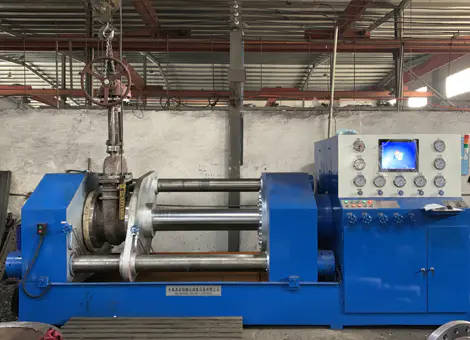Aug 08, 2025
Maintaining a safety valve test bench or hydraulic valve test bench is an important part of ensuring consistent, accurate, and safe valve testing operations. Whether the equipment is used daily in a production environment or only during periodic inspections, a structured maintenance program will help extend the life of the test bench, protect sensitive components, and ensure it operates smoothly over the long term. While every job site has its own unique requirements, there are some practical steps that can be applied to many types of hydraulic test systems to reduce downtime and maintain measurement quality.

Understanding How Hydraulic Valve Test Benches Work
Before you begin routine maintenance, it helps to understand how hydraulic valve test benches work. These test benches are designed to apply hydraulic pressure to valves in a controlled manner in order to measure performance, strength, and sealing capabilities. Typical configurations include hydraulic pumps, control panels, pressure gauges, seals, and fixtures to hold the valves in place during testing.
A safety valve test bench may also include specific features for measuring relief or venting performance. These systems are responsible for confirming that the safety valve opens and reseals within a specified pressure range. Because these operations involve high pressures, keeping the equipment in good condition is critical to safety and compliance.
Components such as seals, fittings and pressure hoses degrade over time. Regular inspections ensure that small problems are discovered before they affect performance or create a safety risk.
Daily and Weekly Visual Inspections
One of the simple but effective ways to keep your hydraulic valve test bench in good condition is to perform regular visual inspections. As the system is used each day, operators can check hoses and connections for signs of wear, cracks or leaks. If hydraulic fluid is found near fittings or on the surface of the test bench, it may be necessary to tighten the connection or replace the seal.
Weekly inspections can focus on instruments, control valves and electrical connections. Control panels should be cleared of dust and debris, as accumulated dust and debris can interfere with switches and displays. Checking that all emergency stops and safety interlocks are functioning properly is also an important step.
Continuous visual inspections can help prevent avoidable failures. Even if no repairs are required, documenting the inspection shows that the equipment has been monitored, which is useful for internal records or audits.
Hydraulic Fluid Management
Hydraulic fluid is central to the operation of any Hydraulic Valve Test Bench. Over time, fluid can accumulate moisture, air bubbles, and contaminants that affect system pressure and component lubrication. Routine fluid analysis and replacement are recommended by most equipment manufacturers.
During maintenance intervals, fluid levels should be checked and topped up as needed. If discoloration or particles are present, the fluid should be drained and replaced. Filters should be cleaned or changed according to the schedule outlined in the equipment manual.
Proper fluid management helps maintain accurate test results and reduces friction inside pumps and cylinders, which can extend the life of internal parts.
Calibration and Performance Verification
A Safety Valve Test Bench depends on precise pressure measurements to ensure valves meet specifications. Over time, gauges and transducers can drift out of calibration, leading to inaccurate readings. Regular calibration using certified instruments helps restore measurement accuracy.
Calibration intervals can vary depending on how often the equipment is used and the conditions in the work area. Some operators schedule quarterly calibrations, while others adjust based on internal quality standards. Recording calibration results provides traceability and helps demonstrate that the system is operating within expected tolerances.
Seal and Hose Replacement
Seals and hoses in a Hydraulic Valve Test Bench experience wear as pressure cycles are repeated. These components should be inspected closely for any changes in shape or texture. If seals appear brittle or hoses have visible cracking, replacement should be scheduled promptly to avoid unplanned downtime.
Having spare seals, hoses, and gaskets on hand reduces waiting time when maintenance is needed. Many manufacturers offer seal kits designed specifically for each model, simplifying replacement procedures.
Electrical System Care
Beyond hydraulic components, electrical elements such as wiring harnesses, switches, and control relays also need attention. Loose connections or worn insulation can lead to intermittent operation or shutdowns. During scheduled maintenance, terminals should be checked for tightness and inspected for corrosion.
Control panels should be kept clean and dry, and indicator lights or displays verified for correct operation. If the system includes software or data logging features, backups and software updates should be part of regular procedures.
Operator Training and Documentation
Even the most thorough maintenance plan depends on well-trained operators. Providing training on correct operation and daily care routines helps avoid unintentional damage and supports safer practices. Clear checklists and maintenance logs can guide operators through inspections and record completed work.
Training sessions can also cover emergency procedures, such as how to shut down the system safely if a leak or other fault is detected during a test.